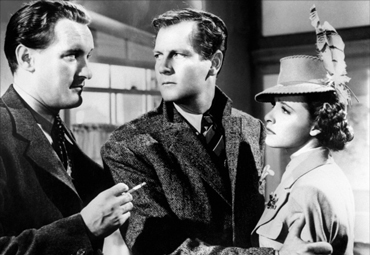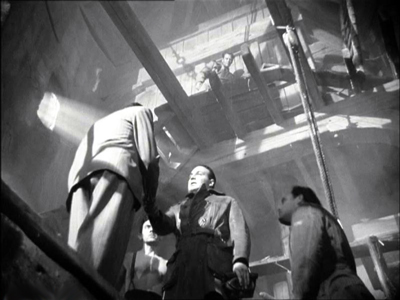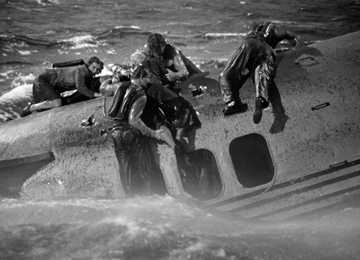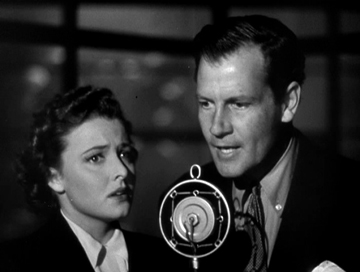
 |
|
|
|
We've had our fill of tell-all biographies about Alfred Hitchcock's alleged sexual obsessions with his leading actresses, a trend that came to a head a couple of seasons back with the shockingly fictitious movie Hitchcock. In the 1940s Hitch was being driven batty in a different way, putting up with David O. Selznick, the powerful producer and talent broker. Selznick brought England's most entertaining director to Hollywood, where the creative possibilities within the massive studio factories seemed unlimited. Hitch had been on a roll with witty U.K. spy thrillers that put attractive amateurs into high jeopardy, fighting assassins on moving trains and fleeing enemy agents on the Scottish moors. Selznick instead first assigned Hitchcock to help fashion a glamorous but overlong romantic thriller, Rebecca. After a flaming finale the characters must continue talking for several minutes to clear away the story deadwood. Selznick was so busy with his other films and with promoting Jennifer Jones that he loaned Hitchcock out several times during the run of his contract. Almost immediately came Foreign Correspondent (1940), a gutsy 'spy' chase given real bite by the international situation. England was already at war, and independent producer Walter Wanger was eager to strike a propaganda blow against Hitler. A committed leftist, Wanger had produced Fritz Lang's critical crime picture You Only Live Once, as well as the somewhat muddled anti-Franco drama Blockade, both starring Henry Fonda. In perhaps the most direct bit of revolutionary theater transferred to the screen, Fonda wails that the Great Democracies are doing nothing to stem the Fascist atrocities in Spain: "Where is the conscience of the World?!" As it turned out, patriot Hitchcock was the tempering influence behind Foreign Correspondent. Wanger salted in dialogue lines referring to Hitler's progress across Europe, but Hitch worked to keep the film's tone as light and entertaining as possible. The movie turns to overt propaganda only at the end, in the brief but famous "The lights are going out all over Europe". Hitchcock critics are much better informed today, but there was a time when they debated the same rather narrow issue: is Hitch's best work his clever '30s spy chases The Secret Agent, The Man Who Knew Too Much, The 39 Steps and The Lady Vanishes? Or do his glossy, star-driven Hollywood thrillers show a maturity in his style: Strangers on a Train, To Catch a Thief, The Man Who Knew Too Much, North by NorthWest, Topaz? 
I'm of the opinion that Foreign Correspondent is the best of Alfred Hitchcock's spy chase thrillers. While not blessed with top box office stars, its leading actors Joel McCrea and Laraine Day are intensely likeable, and Hitchcock puts them through a series of exciting, fresh adventures that never strain credibility, or go for cheap jokes. As with the earlier English classics, Hitchcock makes use of silent movie visual gags to involve the viewer in the action. The easiest of these is the bobbing forest of umbrellas in Holland, which both hide the assassin and reveal his escape path. Hitch also uses visual shorthand to add droll visual jokes, like the hotel sign that suddenly makes its own comment on anxious pre-war Europe. Some of these visual gags are so simple they remind us of the hand-drawn cartoons Hitch reportedly added to silent movie cards when he was just starting out. Although filmed in Los Angeles, Foreign Correspondent is also the kind of fast moving travelogue that Hitchcock preferred. A few of his later VistaVision pictures take time out to observe flower markets, or just admire the countryside. After WW2, breaking countries down into simple references (like Switzerland = chocolate) would have been insulting. Hitch tried a ruthlessly unsentimental spy story in Topaz and nobody felt engaged in the story. The new lovers in Correspondent cuddle and kiss on the deck of a ship crossing the English Channel. He: "You see, I love you and I want to marry you." She: "I love you and I want to marry you." He: "Well, that cuts our love scene down quite a bit, doesn't it?" For once every line of dialogue is a witty gem; there are no clunkers. That's how it should be when talent like Charles Bennett, Joan Harrison, James Hilton and Robert Benchley are properly applied to a script. With the bigger, glossier '50s films name stars take a much bigger role. James Stewart and Doris Day's marital relationship in the Man Who Knew Too Much remake is terribly dated. Day's traumatized mother is sedated before being told that her son has been kidnapped; it's assumed she can't handle the pressure. The frightened couple also break Hitchcock's rule by going to the police early and often. So we have to listen to the cops in scene after scene. 
Finally, career adapter Ernest Lehman turns North by NorthWest into a 'best-of' collection of Hitch's Greatest Chase Hits. When not wowing us with extraordinary set-piece scenes like the Corn Field Crossroads, Lehman baldly repeats situations from earlier films. It's a great movie with marvelous characters. As in most of the '50s Hitchcocks, the bad guys are identified from the moment they're introduced. This by no means is a criticism of any of these Hitchcock pictures, almost all of which are superb entertainments. Foreign Correspondent quickly breaks free of thriller conventions. Its hero Johnny Jones is not a two-fisted adventurer but a crime reporter who loves his Mom, keeps losing his hat and punches out policemen. Half the time the tone is of a screwball comedy. Harry Davenport is Jones' grinning, mischievous editor, and co-writer Robert Benchley is on hand as an alcoholic, slacker foreign correspondent who greets Johnny's boat. When the spy threat becomes more intense, the humor doesn't depart, but instead morphs into proto- James Bond witticisms and caustic observations by George Sanders' good-guy intelligence agent. Haughty and bored-looking in all but the most unpleasant situations, Sanders' unflappable cool is highly entertaining -- and impressively original. 
Finally, Foreign Correspondent has several bravura set piece scenes that for my money top anything before or since in similarly themed Hitchcock pictures. Walter Wanger secured for his director the best technical wizardry in Hollywood, starting with William Cameron Menzies, whose distinctive designs gave shape to many a shaky production. Johnny Jones' escape out a high hotel window is only a refinement on standard matte painting techniques. But Menzies' genius is fully realized in the Holland windmill scene. When he enters the noisy, dust-filled windmill Johnny Jones is trying to determine if the shooting of the beloved Peace advocate Van Meer (Albert Basserman) has been faked. The noise and the turning gears allow Johnny to hide, even when it seems certain that his presence will be discovered. Hitchcock and Menzies use every trick they can think of -- a villain changing his sweaters give Johnny a chance to shift position, for instance. But then Johnny's raincoat gets caught in the gears and is dangled practically in the faces of the bad guys. Every shot in this swift sequence is a complex beauty. What dialogue we do hear is irrelevant - the pictures tell the story, compelling us to share Johnny's experience at a gut level. Before CGI was used for everything, some of the best special film effects were little more than clever slight-of-hand-gags. To escape from the fourth or fifth floor of building under renovation, one of the heroes leaps from a window, rips through an awning and gently alights at sidewalk level. The shot looks like one take, an amazing feat. But closer examination shows the stunt to be constructed in two halves -- the man making the big drop is a dummy, and the actor takes over for the drop through the awning. It always gets applause in theatrical showings. The sequence that really wows 'em is the crash of a flying boat in mid-Atlantic. Here Menzies uses everything he knows to inject realism (1940-style) into the spectacle of a passenger plane shot down by a warship. The ship interior tilts and hand-held cameras reflect the passengers' panic as the cabin floods with real water. The actual moment of crash impact was an expensive "this better work" gag involving large water dump tanks -- it's better seen than explained. When the survivors climb out on the few pieces of the plane still floating, we see real water, rear-screen projected waves and other effects working that are much harder to analyze. The important thing is that the Foreign Correspondent plane crash is still one of the most effective, audience-engaging disaster scenes ever filmed. 
We're told that Alfred Hitchcock resisted letting Foreign Correspondent become an outright attack on Hitler and the Nazis. One factor might have been that patriotic films being made in England were careful not to provoke the Germans too much, for fear of reprisals against Brits already in prison camps. Our Isolationist (read: pro- Bund) congress was censuring Hollywood to curb all propaganda movies. But Correspondent does mention Hitler by name. The epilogue in the BBC radio room as the air raid begins is a message for America to get active, now. It might be too late for England, leaving America as the world's only hope. I think it's one of the most stirring calls to battle ever made by a movie, and all the more effective because of Hitchcock's breezy treatment. The Criterion Collection's Blu-ray + DVD of Foreign Correspondent is quite a surprise. Remastered from its owner Westchester Film, the B&W HD image is gorgeous, far surpassing Warners' earlier DVD and looking like something one might see on a screen in 1940. Alfred Newman's great score (with an infectious little tune to represent the inexperienced Johnny Jones) comes through more strongly than ever. Shots that before were lost in darkness, leaving visual details difficult to assess, are now sharp as a tack. A photo-story Life magazine article arranged by Hitchcock shows how idle rumors hurt the war effort. Joseph Cotten appears in a 1946 radio adaptation, and the insert booklet carries an essay by James Naremore. Effects spokesman Craig Barron provides a lengthy breakdown of the film's wizardly camera tricks, while Mark Harris provides an absorbing visual opinion essay called Hollywood Propaganda and WWII. An episode of the Dick Cavett Show has Hitchcock as its coddled guest. Criterion's Dual-Edition release contains all extras on both Blu-ray and DVD. The In-House producer is Susan Arosteguy.
On a scale of Excellent, Good, Fair, and Poor,
Foreign Correspondent Blu-ray rates:
The version of this review on the Savant main site has additional images, footnotes and credits information, and may be updated and annotated with reader input and graphics.
Review Staff | About DVD Talk | Newsletter Subscribe | Join DVD Talk Forum |
| ||||||||||||||||||